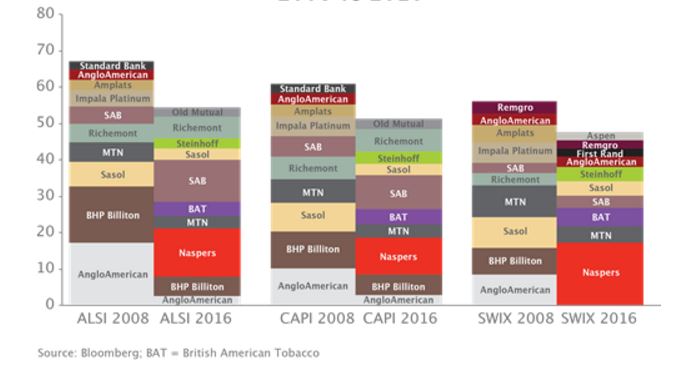Know What You’re Buying
South African index tracking funds
For investors considering adding equity exposure to their portfolios by simply buying an index tracking fund, it’s important to know exactly what you’re buying. That’s because your holdings – and the risk you take – can end up being quite different, depending on which JSE equity index you choose.
The three main market indices for the JSE are the headline All Share (ALSI), the Capped All Share (CAPI), and the Shareholder Weighted Index (SWIX). These three indices have identical stocks as constituents, but their weightings differ. Importantly, they all contain a handful of stocks with very large weights, and a high number of very small stocks whose weights are virtually negligible. This concentration makes index investing risky in South Africa – especially when you might think you’re getting a very broad range of exposure.
Historically, our equity indices have always been very concentrated in the resources sector because of the past resource-heavy nature of the South African economy, and the fact that several global mining firms are listed here. In recent years, however, the resources sector has declined as a result of the global commodity price slump, to be overtaken by the meteoric rise of global media giant Naspers (and a few other companies to a lesser extent). The weight of Naspers alone in the SWIX is currently larger than entire sectors like Healthcare, Consumer Goods, and even Resources.
Concentration of Top 10 FTSE / JSE index shares │ 2008 vs 2016

So what do you get when you buy the three indices now? The table shows the top 10 shares in each index and how they have changed over time.
The ALSI is a basic market capitalisation-weighted index, where each stock is held in proportion to its market capitalisation (or “market cap”, which is the share price of the company multiplied by the number of shares in issue). Naspers is the ALSI’s largest share with a 13.3% weighting, followed by SABMiller at 11.5%.
The SWIX weights stocks according to the amount of their shares included on the South African shareholder register, and excludes those on foreign exchanges. So dual-listed companies have lower weights in the SWIX than in the ALSI. For example, as at 30 June 2016 the weight of BHP Billiton was 5.3% in the ALSI and only 1.2% in the SWIX – the “missing” 4.1% of BHP shares are traded on other exchanges like London, Sydney, etc. and therefore not easily accessible to South Africans. Naspers, meanwhile, has grown to a hefty 17.3% weighting, completely dominating the index – the next largest company is British American Tobacco at 5.1%.
Finally, the CAPI is a capped version of the ALSI, where stock weights are limited to a maximum of 10% each. The impact of this is that smaller shares get a higher weighting in the CAPI compared to the ALSI, giving this index a slight small-cap bias. This fluctuates over time as share prices change between the CAPI’s quarterly rebalancing. Its current Naspers weighting is 10.1%, followed by SABMiller at 9.3% and Richemont at 6.3%.
For investors who are concerned about the dominance of Naspers in the local equity indices, regardless of whether the share might be overpriced, the CAPI could represent a less risky alternative. Interestingly, the JSE plans to introduce a capped version of the SWiX, with a capping level of 10%, in the near future. This will give investors another less-concentrated option to choose from — albeit among the generally more risky universe of equity indices in South Africa.
Index tracking investments are becoming increasingly popular in developed markets like the US, but these equity markets don’t have the same problem of concentration as the JSE. For example, the largest share in the S&P 500 is only 3% of the index. This diversification makes them a more sensible equity investment option than South African index trackers. If you do choose to invest in one, make sure the basket of equities you’re holding matches your risk appetite.
Prudential Investment Managers
Lynn Bolin │ Head of Communications and Media




